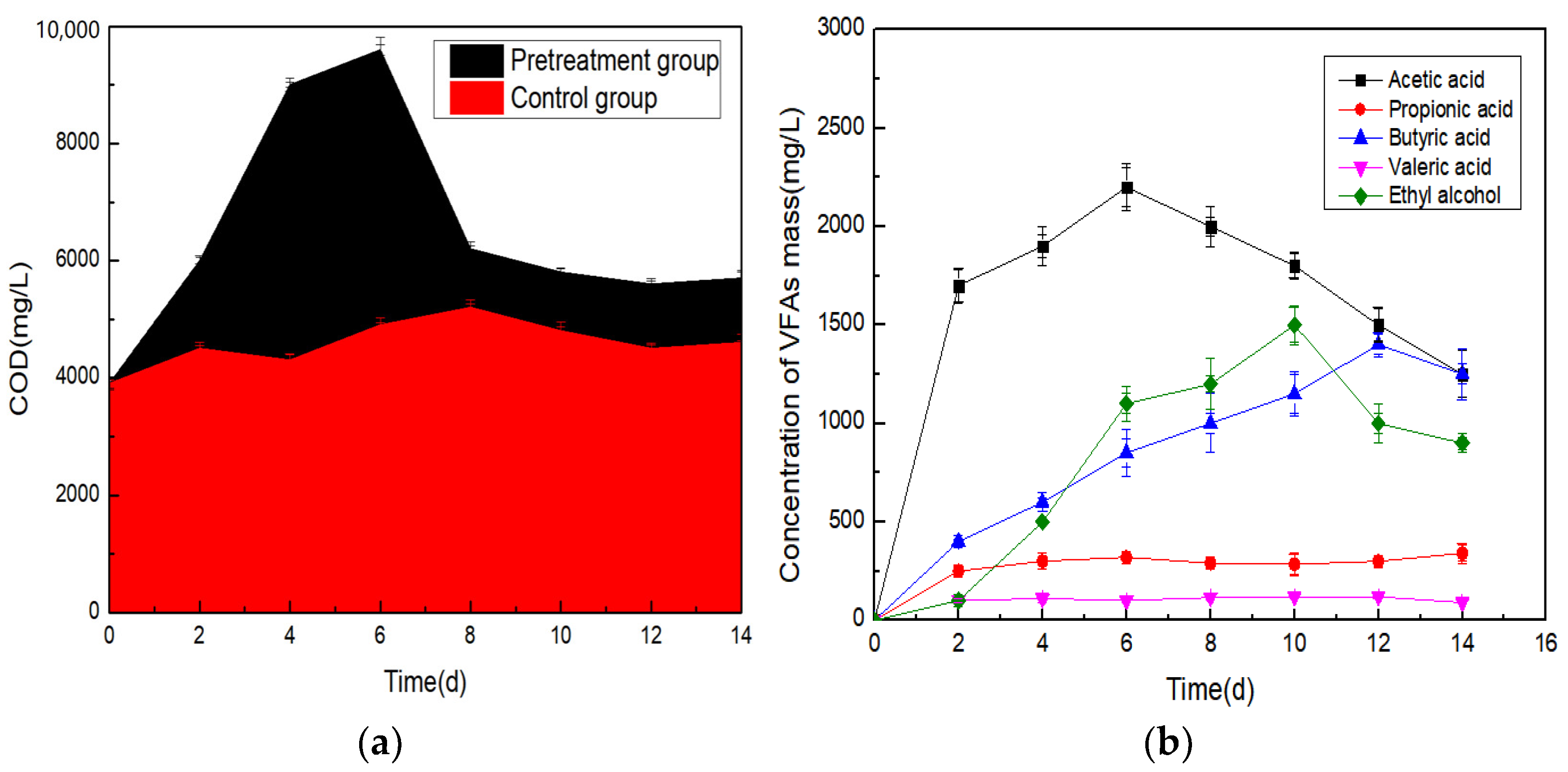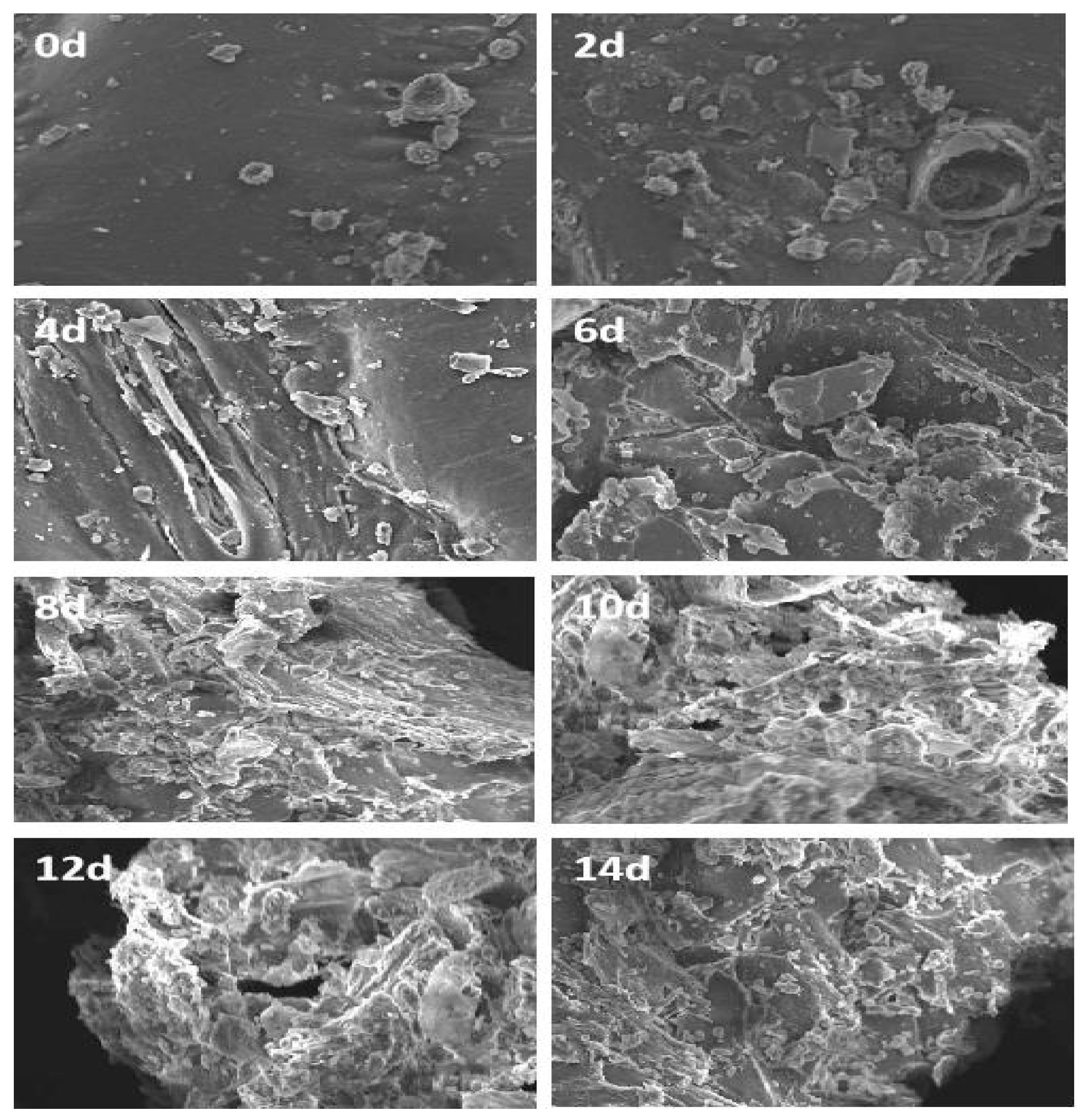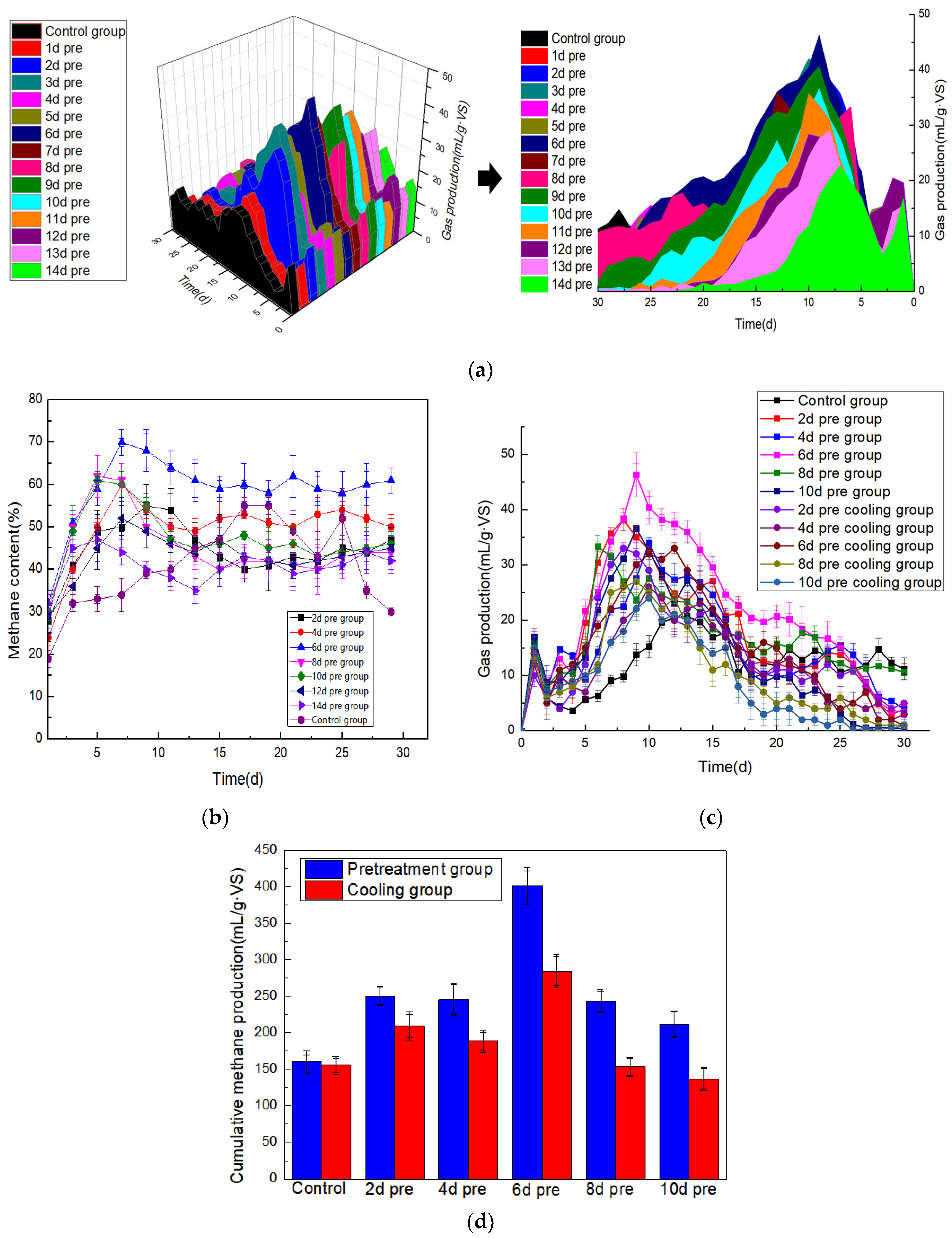Enhancement of Anaerobic Digestion of Corn Straw: Effect of Biological Pretreatment and Heating with Bio-Heat Recovery from Pretreatment
Abstract
:1. Introduction
2. Materials and Methods
2.1. Materials
2.2. Experimental Set-Up
2.3. Modified Gompertz Equation
2.4. Analytical Methods
3. Results
3.1. Temperature Variations
3.2. Variations in the Components of Corn Straw
3.3. Variations in COD and VFAs
3.4. SEM of Corn Straw
3.5. Gas Production via Anaerobic Digestion
3.6. Dynamic Analysis
4. Discussion
5. Conclusions
Author Contributions
Funding
Institutional Review Board Statement
Informed Consent Statement
Data Availability Statement
Conflicts of Interest
References
- Zeng, X.; Ma, Y.; Ma, L. Utilization of straw in biomass energy in China. Renew. Sustain. Energy Rev. 2017, 11, 976–987. [Google Scholar] [CrossRef]
- Huang, J.W.; Zhu, Y.K.; Liu, T.Y.; Sun, S.L.; Ren, J.L.; Wu, A.M.; Li, H.L. A novel wet-mechanochemical pretreatment for the efficient enzymatic saccharification of lignocelluloses: Small dosage dilute alkali assisted ball milling. Energy Convers. Manag. 2019, 194, 46–54. [Google Scholar] [CrossRef]
- Jiao, Y.Z.; Li, P.F.; Li, G.; Zhang, Q.G.; Ding, P.; Wang, S.P.; Gao, Z.; Du, S.L.; He, C. Design and preliminary experimental research on a new biogas fermentation system by solar heat pipe heating. Int. J. Agric. Biol. Eng. 2016, 9, 153–162. [Google Scholar]
- Qiao, W.; Yan, X.Y.; Ye, J.H.; Sun, Y.F.; Wang, W.; Zhang, Z.Z. Evaluation of biogas production from different biomass wastes with/without dydrothermal pretreatment. Renew. Energy 2011, 36, 3313–3318. [Google Scholar] [CrossRef]
- Sindhu, R.; Binod, P.; Pandey, A. Biological pretreatment of lignocellulosic biomass-An overview. Bioresour. Technol. 2016, 199, 76–82. [Google Scholar] [CrossRef]
- Xu, W.Y.; Fu, S.F.; Yang, Z.M.; Lu, J.; Guo, R.B. Improved methane production from corn straw by microaerobic pretreatment with a pure bacteria system. Bioresour. Technol. 2018, 259, 18–23. [Google Scholar] [CrossRef]
- Wei, Y.F.; Li, X.J.; Yu, L.; Zou, D.X.; Yuan, H.R. Mesophilic anaerobic co-digestion of cattle manure and corn stover with biological and chemical pretreatment. Bioresour. Technol. 2015, 198, 431–436. [Google Scholar] [CrossRef]
- Ko, J.J.; Shimizu, Y.; Ikeda, K.; Kim, S.K.; Park, C.H.; Matsui, S. Biodegradation of high molecular weight lignin under sulfate reducing conditions: Lignin degradability and degradation by-products. Bioresour. Technol. 2009, 100, 1622–1627. [Google Scholar] [CrossRef] [PubMed]
- Dittmar, T.; Lara, R.J. Molecular evidence for lignin degradation in sulfate-reducing mangrove sediments (Amazonia, Brazil). Geochim. Cosmochim. Acta 2001, 65, 1417–1428. [Google Scholar] [CrossRef]
- Tian, S.Q.; Zhao, R.Y.; Chen, Z.C. Review of the pretreatment and bioconversion of lignocellulosic biomass from wheat straw materials. Renew. Sustain. Energy Rev. 2018, 91, 483–489. [Google Scholar] [CrossRef]
- Chandra, R.; Takeuchi, H.; Hasegawa, T.; Kumar, R. Improving biodegradability and biogas production of wheat straw substrates using sodium hydroxide and hydrothermal pretreatments. Energy 2012, 43, 273–282. [Google Scholar] [CrossRef]
- Lopez, M.J.; Elorrieta, M.A.; Vargas-Garcia, M.C.; Suarez-Estrella, F.; Moreno, J. The effect of aeration on the bio transformation of lignocellulosic wastes by white-rot fungi. Bioresour. Technol. 2002, 81, 123–129. [Google Scholar] [CrossRef]
- De Gonzalo, G.; Colpa, D.I.; Habib, M.H.; Fraaije, M.W. Bacterial enzymes involved in lignin degradation. J. Biotechnol. 2016, 236, 110–119. [Google Scholar] [CrossRef]
- Janusz, G.; Pawlik, A.; Sulej, J.; Swiderska-Burek, U.; Jarosz-Wilkolazka, A.; Paszczynski, A. Lignin degradation: Microorganisms, enzymes involved, genomes analysis and evolution. FEMS Microbiol. Rev. 2017, 41, 941–962. [Google Scholar] [CrossRef]
- Zhu, Q.L.; Wang, Y.W.; Tan, F.R.; Wu, B.; Dai, L.C.; Hu, G.Q.; He, M.X. Effect of microbial consortium pretreatment and bioaugmentation on biogasification efficiency of corn straw. China Biogas 2019, 37, 11–17. [Google Scholar]
- Ali, S.S.; Al-Tohamy, R.; Manni, A.; Luz, F.C.; Elsamahy, T.; Sun, J.Z. Enhanced digestion of bio-pretreated sawdust using a novel bacteria consortium: Microbial community structure and met hane-producing pathways. Fuel 2019, 254, 115604.1–115604.15. [Google Scholar] [CrossRef]
- Zanellati, A.; Spina, F.; Poli, A.; Rolle, L.; Varese, G.C.; Dinuccio, E. Fungal pretreatment of non-sterile maize silage and solid digestate with a cephalotrichum stemonitis strain selected from agricultural biogas plants to enhance anaerobic digestion. Biomass Bioenergy 2021, 144, 105934. [Google Scholar] [CrossRef]
- Ali, S.S.; Mustafa, A.M.; Kornaros, M.; Manni, A.; Sun, J.Z.; Khalil, M. Construction of novel microbial consortia CS-5 and BC-4 valued for the degradation of catalpa sawdust and chlorophenols simultaneously with enhancing methane production. Bioresour. Technol. 2021, 301, 122720. [Google Scholar] [CrossRef] [PubMed]
- Li, Q.L.; Wang, P.Y.; Tian, T.Y. Modelling of bio-reaction heat in the organic waste anaerobic ferment process. J. Eng. Thermophys. 2009, 30, 649–652. [Google Scholar]
- Xu, M.; Tong, Z.M.; Ye, L. Monitoring of microbial fermentation with calorimetry method. Mod. Food Sci. Technol. 2009, 25, 1193–1195. [Google Scholar]
- Zhuang, Q.B.; Gao, C.; Wang, Y.F.; Zhang, H.N. Red wine fermentation temperature distribution and investigation. J. Agric. Mech. Res. 2011, 33, 170–173. [Google Scholar]
- Klejment, E.; Rosinski, M. Testing of thermal properties of compost from municipal waste with a view on using it as a renewable, low temperature heat source. Bioresour. Technol. 2008, 99, 8850–8855. [Google Scholar] [CrossRef]
- Bialobrzewski, I.; Miks-Krajnik, M.; Dach, J.; Markowski, M.; Czekala, W.; Gluchowska, K. Model of the sewage sludge- straw composting process integrating different heat generation capacities of mesophilic and thermophilic microorganisms. Waste Manag. 2015, 43, 72–83. [Google Scholar] [CrossRef]
- Standard Methods for the Examination of Water and Waste Water 2012, 22nd ed.; American Public Health Association: Washington, DC, USA, 2012.
- Zhang, Q.G.; Li, Y.M.; Jing, Y.Y.; Jiang, D.P.; Zhang, Z.P. Effect of acid and alkaline pretreatment on simultaneous saccharification fermentation for bio-hydrogen production from platanus orientalis leaves. Trans. Chin. Soc. Agric. Mach. 2015, 46, 202–207. [Google Scholar]
- Yuan, X.; Li, P.; Wang, H.; Wang, X.; Cheng, X.; Cui, Z. Enhancing the anaerobic digestion of corn stalks using composite microbial pretreatment. J. Microbiol. Biotechnol. 2011, 21, 746–752. [Google Scholar] [CrossRef]
- Abiodun, O.J. Anaerobic digestion of cyanobacteria and chlorella to produce methane for biofuel. Int. J. Agric. Biol. Eng. 2012, 5, 68–74. [Google Scholar]
- Islam, M.A.; Du, H.; Ning, J.; Ye, H.Y.; Xiong, L.Z. Characterization of glossy1-homologous genes in rice involved in leaf was accumulation and drought resistance. Plant Mol. Biol. 2009, 70, 443–456. [Google Scholar] [CrossRef] [PubMed]
- Singh, D.; Gao, D.F.; Chen, S.L.; Zeng, J.J. Effects of lignin modification on wheat straw cell wall deconstruction by phanerochaete chrysosporium. Biotechnol. Biofuels 2014, 7, 161. [Google Scholar]
- Feng, P.; Zhao, X.Y.; Xi, D.B.; Zhao, X.Y.; Liu, H.Y.; Huang, X.; Xie, J.; Zhang, Y.F.; Gao, X.A. Community composition of biological diversity in microbial inoculum for maize straw decomposition and their effect in methane gas production. Jilin Agric. Sci. 2015, 40, 109–112. [Google Scholar]
- Shi, W.G. Research on producing biogas through treating straw with microbes. Trans. Chin. Soc. Agric. Mach. 2006, 22, 93–95. [Google Scholar]





| C (%) | N (%) | C/N (%) | Cellulose (%) | Hemicellulose (%) | Lignin (%) | TS (%) | VS (%) | |
|---|---|---|---|---|---|---|---|---|
| Corn straw | 49.91 | 1.58 | 31.59 | 43.06 | 19.24 | 17.55 | 92.66 | 81.20 |
| Inoculum | 24.06 | 4.10 | 5.87 | / | / | / | 8.33 | 2.58 |
| Group Number | P (mL/g VS) | Rm (mL/(g d) VS) | λ(d) | R2 | Absolute Percent Deviation (%) |
|---|---|---|---|---|---|
| Control group | 459.63 | 16.91 | 4.56 | 0.9972 | 21.18 |
| 1 d pre group | 408.78 | 17.63 | 5.03 | 0.9976 | 15.06 |
| 2 d pre group | 550.53 | 31.27 | 2.95 | 0.9977 | 2.76 |
| 3 d pre group | 597.35 | 35.62 | 3.36 | 0.9977 | 1.38 |
| 4 d pre group | 506.19 | 26.19 | 3.13 | 0.9966 | 4.55 |
| 5 d pre group | 487.05 | 26.10 | 3.55 | 0.9953 | 5.12 |
| 6 d pre group | 686.66 | 38.21 | 3.64 | 0.9989 | 5.00 |
| 7 d pre group | 505.16 | 32.64 | 3.46 | 0.9978 | 1.28 |
| 8 d pre group | 560.04 | 25.06 | 2.41 | 0.9965 | 6.87 |
| 9 d pre group | 561.42 | 35.63 | 3.49 | 0.9993 | 2.64 |
| 10 d pre group | 441.48 | 30.94 | 3.27 | 0.9989 | 2.91 |
| 11 d pre group | 375.34 | 30.33 | 3.25 | 0.9967 | 2.40 |
| 12 d pre group | 317.50 | 25.03 | 1.80 | 0.9911 | 3.20 |
| 13 d pre group | 281.95 | 25.08 | 2.60 | 0.9944 | 1.75 |
| 14 d pre group | 187.52 | 20.56 | 1.64 | 0.9957 | 0.77 |
| 2 d cooling group | 453.39 | 25.98 | 3.37 | 0.9966 | 1.88 |
| 4 d cooling group | 391.87 | 22.13 | 3.76 | 0.9991 | 5.34 |
| 6 d cooling group | 485.10 | 29.98 | 3.67 | 0.9994 | 4.09 |
| 8 d cooling group | 329.50 | 23.74 | 3.32 | 0.9984 | 1.07 |
| 10 d cooling group | 287.80 | 21.60 | 3.17 | 0.9948 | 3.00 |
Disclaimer/Publisher’s Note: The statements, opinions and data contained in all publications are solely those of the individual author(s) and contributor(s) and not of MDPI and/or the editor(s). MDPI and/or the editor(s) disclaim responsibility for any injury to people or property resulting from any ideas, methods, instructions or products referred to in the content. |
© 2024 by the authors. Licensee MDPI, Basel, Switzerland. This article is an open access article distributed under the terms and conditions of the Creative Commons Attribution (CC BY) license (https://creativecommons.org/licenses/by/4.0/).
Share and Cite
Guan, S.; He, C.; Li, P.; Li, P.; Hou, T.; Gao, Z.; Li, G.; Jiao, Y. Enhancement of Anaerobic Digestion of Corn Straw: Effect of Biological Pretreatment and Heating with Bio-Heat Recovery from Pretreatment. Fermentation 2024, 10, 160. https://doi.org/10.3390/fermentation10030160
Guan S, He C, Li P, Li P, Hou T, Gao Z, Li G, Jiao Y. Enhancement of Anaerobic Digestion of Corn Straw: Effect of Biological Pretreatment and Heating with Bio-Heat Recovery from Pretreatment. Fermentation. 2024; 10(3):160. https://doi.org/10.3390/fermentation10030160
Chicago/Turabian StyleGuan, Shanyue, Chao He, Pengfei Li, Panpan Li, Tingting Hou, Zan Gao, Gang Li, and Youzhou Jiao. 2024. "Enhancement of Anaerobic Digestion of Corn Straw: Effect of Biological Pretreatment and Heating with Bio-Heat Recovery from Pretreatment" Fermentation 10, no. 3: 160. https://doi.org/10.3390/fermentation10030160






